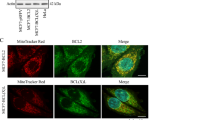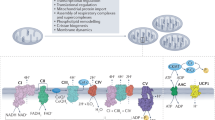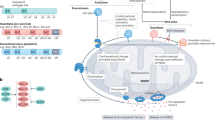Abstract
Mitochondrial respiration, the key process behind cellular energy production, is critical for cell proliferation, growth and survival. However, the regulation of mitochondrial respiratory function in tumor cells is not well understood. In this study, we propose a model whereby tumor cells possess the capacity to fine-tune the balance between energy demands and mitochondrial reactive oxygen species (ROS) status, to maintain a milieu optimal for survival. This is achieved through the moderation of mitochondrial respiration, depending on the ROS context within the organelle, with the main players being Bcl-2 and cytochrome c oxidase (COX). We report a higher level of COX activity, oxygen consumption and mitochondrial respiration in tumor cells overexpressing Bcl-2. Transient overexpression, gene silencing and pharmacological inhibition of Bcl-2 corroborate these findings. Interestingly, Bcl-2 is also able to regulate mitochondrial respiration and COX activity in the face of mounting ROS levels, triggered by mitochondrial complex inhibitors. In this respect, it is plausible to suggest that Bcl-2 may be able to create an environment, most suited for survival by adjusting mitochondrial respiration accordingly to meet energy requirements, without incurring an overwhelming, detrimental increase in intracellular ROS.
Similar content being viewed by others
Log in or create a free account to read this content
Gain free access to this article, as well as selected content from this journal and more on nature.com
or
Abbreviations
- ROS:
-
reactive oxygen species
- COX:
-
cytochrome c oxidase
- ETC:
-
electron transport chain
References
Bensaad K, Tsuruta A, Selak MA, Vidal MN, Nakano K, Bartrons R et al. TIGAR, a p53-inducible regulator of glycolysis and apoptosis. Cell 2006; 126: 107–120.
Matoba S, Kang JG, Patino WD, Wragg A, Boehm M, Gavrilova O et al. p53 regulates mitochondrial respiration. Science 2006; 312: 1650–1653.
Kruse JP, Gu W . p53 aerobics: the major tumor suppressor fuels your workout. Cell Metab 2006; 4: 1–3.
Shibasaki F, Kondo E, Akagi T, McKeon F . Suppression of signalling through transcription factor NF-AT by interactions between calcineurin and Bcl-2. Nature 1997; 386: 728–731.
Hirai I, Wang HG . Survival-factor-induced phosphorylation of Bad results in its dissociation from Bcl-x(L) but not Bcl-2. Biochem J 2001; 359: 345–352.
Harris MH, Thompson CB . The role of the Bcl-2 family in the regulation of outer mitochondrial membrane permeability. Cell Death Differ 2000; 7: 1182–1191.
Chen Q, Vazquez EJ, Moghaddas S, Hoppel CL, Lesnefsky EJ . Production of reactive oxygen species by mitochondria: central role of complex III. J Biol Chem 2003; 278: 36027–36031.
Grivennikova VG, Vinogradov AD . Generation of superoxide by the mitochondrial Complex I. Biochim Biophys Acta 2006; 1757: 553–561.
Clement MV, Hirpara JL, Pervaiz S . Decrease in intracellular superoxide sensitizes Bcl-2-overexpressing tumor cells to receptor and drug-induced apoptosis independent of the mitochondria. Cell Death Differ 2003; 10: 1273–1285.
Adams ML, Pierce RH, Vail ME, White CC, Tonge RP, Kavanagh TJ et al. Enhanced acetaminophen hepatotoxicity in transgenic mice overexpressing BCL-2. Mol Pharmacol 2001; 60: 907–915.
Hockenbery D, Nunez G, Milliman C, Schreiber RD, Korsmeyer SJ . Bcl-2 is an inner mitochondrial membrane protein that blocks programmed cell death. Nature 1990; 348: 334–336.
Nguyen M, Millar DG, Yong VW, Korsmeyer SJ, Shore GC . Targeting of Bcl-2 to the mitochondrial outer membrane by a COOH-terminal signal anchor sequence. J Biol Chem 1993; 268: 25265–25268.
Nijtmans LG, Taanman JW, Muijsers AO, Speijer D, Van den Bogert C . Assembly of cytochrome-c oxidase in cultured human cells. Eur J Biochem 1998; 254: 389–394.
Lee M, Hyun DH, Halliwell B, Jenner P . Effect of overexpression of wild-type and mutant Cu/Zn-superoxide dismutases on oxidative stress and cell death induced by hydrogen peroxide, 4-hydroxynonenal or serum deprivation: potentiation of injury by ALS-related mutant superoxide dismutases and protection by Bcl-2. J Neurochem 2001; 78: 209–220.
Kowaltowski AJ, Fenton RG, Fiskum G . Bcl-2 family proteins regulate mitochondrial reactive oxygen production and protect against oxidative stress. Free Radic Biol Med 2004; 37: 1845–1853.
Steinman HM . The Bcl-2 oncoprotein functions as a pro-oxidant. J Biol Chem 1995; 270: 3487–3490.
Hao JH, Yu M, Liu FT, Newland AC, Jia L . Bcl-2 inhibitors sensitize tumor necrosis factor-related apoptosis-inducing ligand-induced apoptosis by uncoupling of mitochondrial respiration in human leukemic CEM cells. Cancer Res 2004; 64: 3607–3616.
Zhuge J, Cederbaum AI . Serum deprivation-induced HepG2 cell death is potentiated by CYP2E1. Free Radic Biol Med 2006; 40: 63–74.
Pelicano H, Feng L, Zhou Y, Carew JS, Hileman EO, Plunkett W et al. Inhibition of mitochondrial respiration: a novel strategy to enhance drug-induced apoptosis in human leukemia cells by a reactive oxygen species-mediated mechanism. J Biol Chem 2003; 278: 37832–37839.
Li N, Ragheb K, Lawler G, Sturgis J, Rajwa B, Melendez JA et al. Mitochondrial complex I inhibitor rotenone induces apoptosis through enhancing mitochondrial reactive oxygen species production. J Biol Chem 2003; 278: 8516–8525.
St-Pierre J, Buckingham JA, Roebuck SJ, Brand MD . Topology of superoxide production from different sites in the mitochondrial electron transport chain. J Biol Chem 2002; 277: 44784–44790.
Muller FL, Liu Y, Van Remmen H . Complex III releases superoxide to both sides of the inner mitochondrial membrane. J Biol Chem 2004; 279: 49064–49073.
Clement MV, Stamenkovic I . Superoxide anion is a natural inhibitor of FAS-mediated cell death. EMBO J 1996; 15: 216–225.
Acknowledgements
This work is supported by grants from the National Medical Research Council, the Biomedical Research Council, and the NUS Academic Research Fund to SP The authors wish to thank Jayshree L Hirpara and Rathiga Velaithan for rendering generous technical assistance and advisory support as well as Dr. Deng Yuru and Dr. Wang Chunming for the provision of Hansatech Oxytherm electrodes for oxygen consumption studies.
Author information
Authors and Affiliations
Corresponding author
Additional information
Edited by P Bouillet
Supplementary Information accompanies the paper on Cell Death and Differentiation website (http://www.nature.com/cdd)
Supplementary information
Rights and permissions
About this article
Cite this article
Chen, Z., Pervaiz, S. Bcl-2 induces pro-oxidant state by engaging mitochondrial respiration in tumor cells. Cell Death Differ 14, 1617–1627 (2007). https://doi.org/10.1038/sj.cdd.4402165
Received:
Revised:
Accepted:
Published:
Issue date:
DOI: https://doi.org/10.1038/sj.cdd.4402165
Keywords
This article is cited by
-
Cell-specific modulation of mitochondrial respiration and metabolism by the pro-apoptotic Bcl-2 family members Bax and Bak
Apoptosis (2024)
-
Mitochondrial metabolism as a potential therapeutic target in myeloid leukaemia
Leukemia (2022)
-
BCL(X)L and BCL2 increase the metabolic fitness of breast cancer cells: a single-cell imaging study
Cell Death & Differentiation (2021)
-
Venetoclax causes metabolic reprogramming independent of BCL-2 inhibition
Cell Death & Disease (2020)
-
Oncogenic pathways and the electron transport chain: a dangeROS liaison
British Journal of Cancer (2020)



